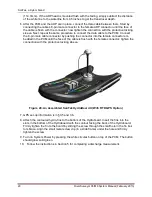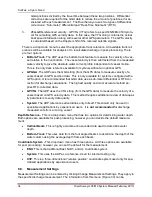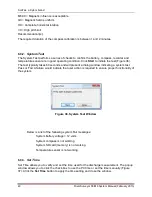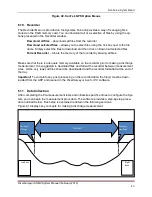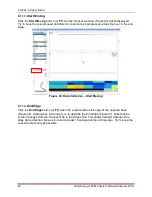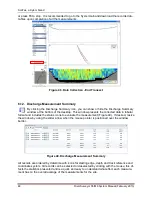
SonTek, a Xylem brand
RiverSurveyor S5/M9 System Manual (February 2013)
33
Salinity
– This user-defined parameter allows for a correction of the speed of sound in water
based on the salinity in parts per thousand (ppt) at the face of the ADP. A value representative
of the local water conditions must be entered manually to avoid potential erroneous calculations.
For reference, the salinity range is between 0 ppt (freshwater) to 34.5 ppt (seawater). Water
temperature is also a factor for speed of sound in water calculations. The ADP has a built-in
temperature sensor that automatically compensates for this effect.
Magnetic Declination
– On the earth's surface, a calibrated compass indicates magnetic North
rather than geographic North. The angular difference between these two directions is called
magnetic declination (also known as variation, magnetic variation, or compass variation). Mag-
netic declination varies across the earth's surface and over time. The ADP compass is calibrat-
ed at the factory; however, calibration is required at each site to remove any local magnetic in-
terference. Compass calibration will ultimately give better measurement accuracy. The magnetic
declination angle (θ) can be found on maps, like the one presented in Figure 32. Magnetic dec-
lination resources can also be found on many sites on the internet.
Figure 32. Magnetic Declination Map of the World
Track Reference
– The ADP measures a water velocity using the Doppler shift principle, using
multiple acoustic pulses transmitted and received throughout the water column. When the ADP
is in motion, the water velocity actually measured by the ADP is a combination of boat velocity
and water velocity. In order to determine true water velocity the boat speed must be known and
then subtracted from the actual water velocity measurement. The RiverSurveyor “moving boat“
discharge application uses three methods (references) to determine boat velocity.
1.
Bottom-Track reference velocity: The ADP itself is capable of determining boat
speed using a technique called “Bottom-Track”. In this case, bottom-track velocity is
calculated using the Doppler shift received from multiple acoustic pulses (transmitted
from the ADP) that have reflected off of the riverbed. If the riverbed is stationary (i.e.
non-moving bottom), then the Doppler shift velocity will consist entirely of boat speed
velocity which is acceptable for discharge calculations. If the riverbed is in motion the
Doppler-shift-based velocity will consist of both boat speed and riverbed speed which
will bias discharge calculations. In this case, the following two references would be
preferred to determine boat velocity.
2.
GGA GPS-referenced velocity: GPGGA (GGA) refers to a specific NMEA-0183 pro-
tocol for outputting GPS position data. In this case, the GGA “string” contains actual
position (latitude/longitude) information along with several other GPS quality parame-
ters. Boat velocity is calculated by measuring the distance between two successive


